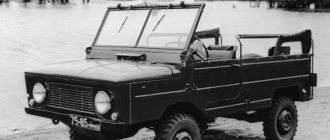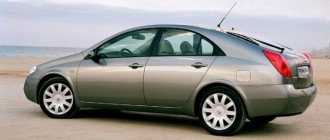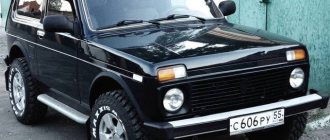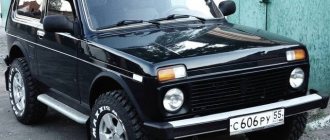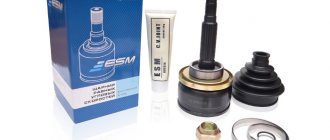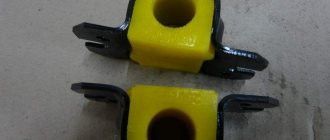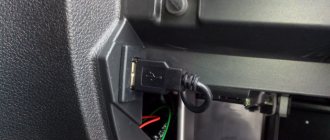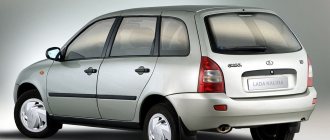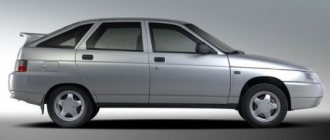General description of the family
- (1967-69);
- (1969-75);
- (1975-1979);
- (1979-1992);
Also closely related to it are automobiles:
The transmission output signal is transmitted through the driveshaft to one or more differentials, while a differential may also provide gear transmission, its main purpose is to allow the wheels at either end of the axle to rotate at different speeds as it changes direction of rotation. Early gears included right angle drives and other gearing in windmills, horsepower and steam engines, in support of pumping, milling, most modern gearboxes are used to increase torque while reducing the speed of the prime mover output shaft.
- LuAZ-1302
; - LuAZ-2403
; - LuAZ-1301
;
LuAZ-969 was the first-born of the domestic automotive industry in a number of ways. It was the first domestic front-wheel drive car (version “969B” without rear axle drive); the first SUV that was a consumer item, that is, officially sold “for personal use”; the first production domestic car created specifically for the needs of village residents.
This means that the transmission shaft rotates at a lower speed than the input shaft. The gearbox can be set to the opposite and provides increased speed as torque decreases. Some of the simplest gearboxes simply change the direction of rotation of the power transmission.
Many typical automotive transmissions include the ability to select one of several ratios, in which case the majority of the ratios are used to slow the engine's output speed and increase torque. Volyn region - Volyn region is a region in the north-west of Ukraine. Kovel is the westernmost city, and the last station in Ukraine is the line from Kyiv to Warsaw. During the interwar period, much of the territory, organized as Volyn Voivodeship, was under Polish control, many Ukrainians rejoiced at reunification, but the Polish minority suffered a cruel fate.
The functional design and simplified bodywork, which provided only the most minimal comfort, corresponded to the purpose of the car, and its cross-country ability is outstanding to this day.
The car caused and still causes polar assessments and opinions. Many owners note the very high cross-country ability and practicality of LuAZ vehicles. Others criticize them for their low quality of workmanship, low comfort, very difficult access to the front seats, labor-intensive maintenance and lack of dynamics. Objectively, this car was generally not bad for what it was created for - use in rural areas, mainly on bad roads, where high maximum speed is not important, and good interior trim only makes it more difficult to clean it from the dirt that is inevitable in such conditions. The obvious disadvantage of the car was the Zaporozhets engine - noisy and not powerful enough, which was corrected in later modifications.
Thousands of Poles, especially retired Polish officers and intellectuals, were deported to Siberia, most of these deportees died in the extreme conditions of Soviet labor camps, and most of them were never able to return to Volhynia. The region became the basis of several networks, and many members of the population served the guerrillas. Poles in the area of part of the Polish Army. When they became disillusioned with the Nazi program, they began to target all non-citizens for elimination. Most Poles remaining in the region were forced to leave for the Recovered Territories of western Poland, whose German population had been expelled.
Light SUVs of similar class for the army or village residents were also created abroad - for example, the West German DKW Munga (1956-1968), Haflinger (1959-1974) and Volkswagen Iltis (1978-1988), the East German one, adopted for service The Soviet army as a TPK is a “front line transporter.”
During the Korean War (1949-53), there was a need for a lightweight, floating all-terrain vehicle for transporting ammunition, evacuating the wounded from the battlefield, reconnaissance, towing light guns and mortars, and similar tasks. GAZ-69, for all its positive qualities, was not quite suitable for performing these functions, just like the overly specialized amphibian GAZ-46 (MAV - “small waterfowl vehicle”) created on its basis.
Some of the Ukrainians on the side, especially around the city of Kholm, were also forcibly resettled in Ukraine. The area experienced rapid industrialization, including the construction of the Lutsk Automobile Plant, yet the area remains one of the most rural areas of the former Soviet Union.
Disc Brake - Motion energy is converted into waste heat which must be dissipated. Hydraulic disc brakes are the most commonly used form of brake for cars; compared to drum brakes, disc brakes provide better stopping because the disc cools more easily. As a result, discs are less susceptible to brake fade caused by overheating brake components, and disc brakes also recover faster from sinking. Most drum brake designs have at least one leading shoe that produces a servo effect, and this tends to give the driver better feel and help avoid impending lockup.
Development began in the mid-fifties in NAMI by a group led by B. M. Fitterman. The prototype, designated NAMI-049 (some sources mention the all-terrain vehicle’s own name - “Ogonyok”), was ready by 1958. It had a fiberglass body with a reinforced load-bearing base, independent torsion bar suspension on trailing arms, permanent drive to the front and rear axles connected through a lockable center differential, lockable axle differentials, wheel drives and a 22 hp MD-65 motorcycle engine. The latter turned out to be too weak, had a short resource and did not develop the proper traction properties. In addition, the plastic body turned out to be too fragile.
Drums are also prone to bellhousing penetration and trapping of lining wear material in the assembly, with the brake rotor typically made of cast iron, but in some cases it may be made of composites such as reinforced carbon-carbon or ceramic matrix composites. However, the choice of metals during this period meant that he had to use copper as the braking medium acting on the disc. Instead of a disc with a caliper compressing on it, this system used twin discs that were rubbed onto the surface of a cast iron brake drum.
The second sample was designated NAMI-049A. Specialists from NAMI and the Zaporozhye plant, who in those years were working on the project of the Zaporozhets small car, were involved in its participation. For the military amphibian, one of the engine options designed for the Zaporozhets was considered suitable - a V-shaped, four-cylinder, air-cooled. Further work on the small car and the amphibian was carried out in parallel.
The discs move apart to create friction against the surface of the drum through the action of standard wheel cylinders. Servo. In control engineering, a servo mechanism, sometimes shortened to servo, is an automatic device that uses negative error feedback to correct the action of the mechanism. It typically includes a built-in encoder or other position feedback mechanism to ensure that the output achieves the desired effect, a term properly applied only to systems in which feedback or error correction signals help control mechanical position, speed, or other parameters.
The NAMI-049A engine was basically unified with the serial engine of the Zaporozhets, but it also had significant differences - first of all, on the Zaporozhets the engine was located at the rear and was not cooled by the incoming air flow, which required the introduction of forced air cooling using a fan ( However, the ZAZ engine still often overheated in hot weather, and on the future LuAZ, on which it was installed at the front, even despite greater loads, such a tendency was not observed).
For example, the power window control is not a servo mechanism. In contrast, car cruise control uses closed-loop feedback, which classifies it as a servo mechanism, the general type of servo provides position control. Typically servos are electrical, hydraulic, or pneumatic, and they operate on the principle of negative feedback, where the control input is compared with the actual position of the mechanical system as measured by some kind of output transducer.
Any difference between the actual and desired values is amplified and used to control the system as necessary to reduce or eliminate the error. This procedure is a widely used application of control theory; typical servo motors can produce either rotary or linear output. Speed control through a governor is another type of servomechanism, a steam engine uses mechanical governors, another early application is regulating the speed of water wheels. Many autofocus cameras also use a servo mechanism to move the lens precisely, and the hard drive has a magnetic servo system with micromimeter precision.
In addition, instead of a plastic body, they used an open steel one with an awning, abandoned the center differential, and made the rear axle disengageable. The suspension was strengthened to enable parachute landing. The driver's seat was placed in the middle of the car, the orderly sat with his back to him, and the sides of the body were occupied by stretchers with the wounded. There was no propeller - on water the car moved by rotating the wheels, so compared to “real” amphibians it was less adapted to swimming, but more suited to moving on land.
In industrial machines, servos are used to perform complex movements, a servo motor is a special type of motor that is combined with a rotary encoder or potentiometer to form a servomechanism. This assembly, in turn, can become part of another servomechanism. Potentiometers are subject to drift with temperature changes, while sensors are more stable, servo motors are used for both high and low performance applications. At the high end are precision industrial components that use a rotary encoder, at the low end are low-cost radio-controlled servos used in radio-controlled models that use a free-running motor and a simple potentiometer position sensor with a built-in controller.
In its final form, the car received the designation LuAZ-967 and began to be produced in Lutsk in 1961. Before this, the plant repaired vans, manufactured shower units and TSM-6.5 conveyors for silage.
Design[edit | edit code]
The body of the LuAZ-969 car is semi-supporting, with an integrated spar-type frame. The layout of the car is characterized by a strong displacement of the passenger compartment forward, which made it possible to achieve a constant high load on the front axle, thereby ensuring high traction and grip properties even when driving only the front wheels.
The engine is a V-shaped, four-cylinder, very close to the engines of small cars of the Zaporozhets brand. Until 1975, LuAZ was equipped with a MeMZ-969 engine with a displacement of 877 cm³ and a power of 30 hp. With. (analogous to Zaporozhets engines models 965A and 966B), after - MeMZ-969A, 1197 cm³ and 40 hp. With. (analogue 968). Regardless of the version, the engines were equipped with a cooling system with a forcing (and not an exhaust, as in early Zaporozhets models) fan, which took air through a grille in the front end lining and drove it through the cooling jackets of the engine heads and cylinder block, while the direction of the flow The air was set by a system of sheet metal casings installed on the engine (much less developed, however, than on later Zaporozhets models). In addition, the lubricating oil circulating in the engine was cooled in the oil cooler and in the engine crankcase, the pan of which had a ribbed surface that facilitated heat dissipation. Unlike the Zaporozhets, there were no thermostats in the engine cooling system; the engine temperature during warm-up and in winter conditions was maintained manually by the driver due to the blinds installed between the front end lining and the fan, driven by a handle on the instrument panel (which was much more reliable than automatic adjustment of air flows on "Zaporozhets"). Made as a separate unit, the interior heater could be used in winter to preheat the engine.
Transmission diagram for LuAZ vehicles (all-wheel drive version).
The LuAZ transmission as a whole is characterized by a comparative simplicity of the device by the standards of SUVs (double-shaft gearbox, absence of cardan shafts and transfer case), which has a positive effect on the weight-dimensional characteristics and reliability. The main gear and twin-shaft gearbox are located in the front of the car and are combined into a single unit (transexl), partly similar to that used on Zaporozhets cars (the crankcase, except for the rear cover, and many other parts are unified with the gearbox of 1.2-liter 40-horsepower models "Zaporozhtsev"). Gear shifting is carried out by a floor lever located on the rear cover of the gearbox housing, and the shift layout differs from the traditional one (“mirror”): the first gear is engaged by moving the lever from neutral towards you and back, the second - towards you and forward, the third - from neutral back , fourth - from neutral forward, reverse - from neutral away from you and forward. A power take-off mechanism from the secondary shaft, used either to drive various agricultural equipment, or (on all-wheel drive versions) to drive the rear axle, and (also on all-wheel drive versions) a reduction gear is also mounted inside the gearbox housing cover.
From the very beginning, the gearbox of LuAZ cars had a fully synchronized series of forward gears and a hydraulic clutch (its external feature is a technological connector in the middle of the main gear housing) - unlike the Zaporozhets, whose versions with engines with a working volume of 750 and 877 cm³ were equipped with a different architecture (“Fiat”) gearbox with unsynchronized first gear and cable-operated clutch (with a technological connector between the clutch bell and the gearbox housing itself). The LuAZ variants with the 877 cc MeMZ-969 engine differed from the later 1.2-liter ones only in a different clutch bell (made together with the front half of the final drive housing). The gearbox for the Zaporozhets with a 1.2-liter engine was designed on the basis of the LuAZ transmission by eliminating the power take-off mechanism with reduction gear from its design, installing a pair of fourth gear gears with a higher gear ratio and developing a new gear shift mechanism designed for remote traction drive.
For all-wheel drive modifications, rotation is transmitted from the power take-off shaft of the gearbox to the rear axle gearbox using a thin shaft without hinges, enclosed inside the transmission pipe connecting the gearbox and rear axle housings. Thus, all the vehicle’s transmission units, except for the axle shafts, are essentially enclosed in a common sealed crankcase, which is a legacy of LuAZ’s amphibious past. The rear axle is disabled in the normal state of the transmission; it can be connected from the driver’s seat, for which it is necessary to move the lever located to the left of the gearshift lever to the rear position (with the lever in the forward position, the rear axle is correspondingly disabled). There is no center differential, so when driving on paved roads, the rear axle must be disengaged, and the car becomes front-wheel drive. The same lever also controls the inclusion of a downshift - to engage it in the connected rear axle mode, you must move the rear axle connecting lever away from you and move it forward, while the gearbox lever must be in the neutral position.
To prevent one of the rear wheels from slipping, the rear axle differential can be forcibly locked from the driver's seat by a curved lever located next to the parking brake lever. The locking mechanism is with a gear coupling. There is no front axle differential lock.
The suspension is torsion bar, on trailing arms, with large strokes. The wheels are 13-inch, with a developed mud tread pattern. The wheel pattern corresponds to that used on rear-wheel drive Moskvich cars, but the wheels themselves are original, with a large positive offset, and, unlike other AvtoZAZ products, they have a disk design.
Brakes are drum brakes on all wheels, hydraulically driven, without power assistance.
Development and development in production
This model was equipped, like its predecessor, with a 1.2-liter 40-horsepower MeMZ-969A engine, but was equipped with a separate brake drive with a hydraulic vacuum booster on the front circuit. The exterior of the car was modernized by changing the front panels and changing the shape of the windshield. The doors are equipped with locks, the door windows received a rigid frame and opening “windows”, a soft instrument panel, a safety steering column and “Zhiguli” seats appeared in the cabin.
Even before the launch of the series, the LuAZ-969M was highly praised at the Exhibition of Economic Achievements of the USSR, and in 1978 at the international salon in Turin (Italy) it entered the top ten best cars in Europe. In 1979, at an international exhibition in the city of Ceske Budejovice (Czechoslovakia), he received a Gold Medal as one of the best cars for village residents.
LuAZ-2403 was created on the basis of this vehicle.
.
LuAZ-1302
In 1990, production of LuAZ-1302
with an engine from Tavria - MeMZ-245, 53 hp.
There were no external differences from the 969M. The car had reinforced side members, a new instrument panel, additional noise and vibration insulation and more comfortable seats from Tavria. Fuel consumption and noise have decreased significantly, dynamics have improved.
LuAZ-1302
Combat assistance
Realizing that the help of “senior comrades” is good not only during the trophy, but also in preparation for them, Kirill turned to those who have been tuning SUVs for more than ten years. Of course, everything was done wisely.
As soon as the craftsmen exposed the body, they discovered that the bottom had turned into a real sieve - you could even pick mushrooms without leaving the car. The entire floor was cut away, replaced with thick steel panels reinforced with crossbars. A metal booth was placed on the body, giving it a more or less aesthetic appearance. Since there was little space in the car for expedition equipment, it was decided that there would be a large trunk on the roof, which would accommodate the main luggage. Despite the owner's doubts, the fuel tank was moved from under the floor into the cabin, behind the seats, forcing Kirill to look for a plastic tank from the Gazelle. They also installed an additional battery of decent capacity in the cabin, under the passenger seat.
The standard generator, of course, was replaced with a new one from a VAZ-2110. We cut out all the old electrical wiring and laid a new one, raising it above the level of the carburetor. The fuse box is located in the cabin. A snorkel was brought to the carburetor, into which the transmission breathers were pulled. The body was raised above the torsion bars by 40 mm. We made new power bumpers and added a rear winch - also a Mile Marker. The sides were protected with power thresholds. We also made protection for the engine crankcase. The headlights were replaced with tank ones, which are not afraid of impacts from stones and branches, and additional optics were installed on the expeditionary trunk - four headlights in the front and two in the rear. The hi-jack was also fixed there.
At the rear, for easy access to luggage, a small ladder was placed on the roof. And from the corners of the “basket” to the kengurin, made of a pipe-fifty, steel rails were stretched - branch guards. The body, of course, was repainted in camouflage, which gave the car a combative, stern look. And Kirill’s latest acquisition to date was a powerful pneumatic horn - a chrome “pipe” on the roof. It is unnecessary? Well, don't tell me. After all, despite all its ammunition, the “Luazik” remained a “Lunokhod”... You can’t make a trophic “cutlet” out of it, no matter how you look at it. However, Kirill doesn’t want to. You can get the full off-road experience with a car like it is now. We still need to learn how to use its capabilities.
The many faces of “Volyn”
A family of Soviet cargo-passenger mini-off-road vehicles - LuAZ-969 "Volyn", produced at the Lutsk Automobile Plant from 1967 to 1992. The modernized LuAZ-1302 (with the MeMZ-245-20 engine) was produced from 1988 to 2001.
LuAZ-969 was the first-born of the domestic automotive industry in a number of ways. It was the first domestic front-wheel drive car (version 969B without rear axle drive); the first SUV (969), which was a consumer item, that is, officially sold “for personal use”; the first production domestic car created specifically for the needs of village residents. The LuAZ was made extremely simple, achieving maximum unification with the Zaporozhets. This caused both advantages and disadvantages. Many owners note the very high cross-country ability and practicality of LuAZ vehicles. Others criticize them for their low quality of workmanship, low comfort, difficult access to the interior, labor-intensive maintenance and disgusting dynamics.
And yet, the LuAZ-969M modification was highly praised at the Exhibition of Economic Achievements of the USSR, and in 1978, at the international salon in Turin, as indicated in a number of sources, LuAZ entered the top ten best cars in Europe. In 1979, at an international exhibition in the city of Ceske Budejovice (Czechoslovakia), he received a Gold Medal as the best car for village residents.
Objectively, this car as a whole was not bad for what it was created for - use in rural areas, mainly on bad roads, where maximum speed is not important, and good interior trim only makes it more difficult to clean it from the inevitable dirt. The only obvious drawback of the car was the engine - noisy and not powerful enough, which was partly corrected in later modifications.
Light SUVs of similar class for the army or rural residents were also created abroad - for example, the West German DKW Munga (1956–1968), Haflinger (1959–1974) and Volkswagen Iltis (1978–1988), and the East German Wartburg 353–400 Jagdwagen. Likewise, our civilian LuAZ-969 inherited much from the LuAZ-967 amphibian, which was produced in Lutsk since 1961 and was in service with the Soviet Army as a front-line transporter.
LuAZ became the basis for many modifications for a wide variety of purposes - from beach cars to airfield tractors and even dump trucks. And the most interesting of them is the combat vehicle in service with the modern Ukrainian army. This is an MLRS (multiple launch rocket system)!
LuAZ-969 and its modifications received the nicknames “Lumumzik”, “Pepelats”, “Lunokhod”, “Louise”, “Volynyanka”, “Bolynka”, “Losharik”, and modifications with engines from “Zaporozhets” and “Tavria” were called respectively “Birds” and “Dropsies”.
Based on materials from www.wikipedia.org
LuAZ-1302: Micro-Gelik combat
Modifications
Family "969"
- (1967-69) - temporary version, front-wheel drive;
- (1969-75) - serial with a 4x4 wheel arrangement;
- (1975-1979) - first modernization, MeMZ-969A engine;
- (1979-1992) - second modernization, updated body;
Family "1302"
- LuAZ-13021
(prototype) is a long-wheelbase cargo modification of the 969M in factory version. Subsequently, the type of onboard body was changed, and the base for the production model became 1302; - LuAZ-13021
is a serial cargo modification of model 1302. Some versions of this truck were equipped with a gearbox from Moskvich-2141 without a rear axle drive; - LuAZ-13021-03
- modification of model 13021 with a normal rigid cabin and a sunroof; - LuAZ-13021-04
is a long-wheelbase cargo-passenger modification of model 1302, created for mobile repair teams to maintain power lines and pipelines. The double cab seats four, and the shortened cargo platform can carry up to 250 kg of cargo; - LuAZ-1302-05 “Foros”
is another modification of the 1302 model, distinguished by its design and open body with roll bars;
wheel arrangement - 4x4 load capacity - 400 kg curb weight - 970 kg gross weight - 1370 kg dimensions length - 3430 mm width - 1610 mm; height - 1754 mm; ground clearance - 280 mm; base - 1800 mm; track - 1360 mm; engine 37-horsepower Italian diesel “Lombardini” LDW 1404. number of cylinders - 4; working volume 1372 cm³; power at 3600 rpm - 37.4 hp; torque 8.47 kgf.m at 2200 rpm; maximum speed 100 km/h; fuel consumption - 7.7 liters per 100 km; maximum lift angle 60%; maximum lateral stability angle - 40 degrees; ford depth - 0.5 m; wheels - rims - 51/2J/13; — tires — 186/65R13.
- LuAZ-13021-07
- a variant of model 13021-04 with an extended van-type body with a fiberglass top and a metal tailgate; - LuAZ-13021-08
is a modification of model 13021-07 for the Ambulance service. The top is made of fiberglass. To conveniently accommodate stretchers, the rear part of the body has been lengthened by more than 600 mm, resulting in an increased rear overhang. The body has four doors: one on the left, two on the right and a rear one;
The car was purchased in 2012, with virtually no working brakes and 360 degrees of play in the steering. In 2014-2015, the car was brought to its current (working) condition.
A machine for the soul and relaxation.
LuAZ-969 “Volyn” is a family of Soviet cargo-passenger mini-passenger cross-country vehicles, produced at the Lutsk Automobile Plant from 1966 to 2001.
The family included the following models:
LuAZ-969V (1967-72) - front-wheel drive, with a power take-off shaft; LuAZ-969 (1971-75) - all-wheel drive, with rear differential lock; LuAZ-969A (1975-1979) - modernization of LuAZ-969. Engine 1.2 l, 40 hp; LuAZ-969M (1979-1996) - modernization of LuAZ-969A. Separate brake drive, new exterior and interior lines.
LuAZ-969 was the first Soviet front-wheel drive car (the “969B” version without rear axle drive). Also, LuAZ-969 is the first SUV that was a consumer item, that is, officially sold “for personal use.” In addition, LuAZ-969 is the first serial Soviet car created specifically for the needs of village residents.
The functional design and simplified bodywork, which provided only the most minimal comfort, corresponded to the purpose of the car, and its cross-country ability is outstanding to this day.
The car caused and still causes polar assessments and opinions. Many owners note the very high cross-country ability and practicality of the Volyn. Others criticize them for their low quality of workmanship, low comfort, very difficult access to the front seats, labor-intensive maintenance and lack of dynamics. Objectively, this car was generally quite good for the tasks that were assigned to it - operation in rural areas, mainly on bad roads, where high maximum speed is not important, and good interior trim only complicates its cleaning from the dirt that is inevitable in such conditions. Inconvenient access to the driver's seat is the downside of the car's layout, which ensures good loading of the front axle and, accordingly, high cross-country ability even with the rear axle disabled. An obvious objective disadvantage of the car was the Zaporozhets engine - noisy, insufficiently powerful and short-lived, having a torque curve unfavorable for an all-terrain vehicle - which was corrected in later modifications. The difficulty of maintenance corresponds to the design features of the chassis of an all-wheel drive vehicle with a rather complex transmission.
Light SUVs of similar class for the army or rural residents were also created abroad - for example, the West German DKW Munga (1956-1968), Haflinger (1959-1974) and Volkswagen Iltis (1978-1988), Farmobil (1962-1966), East German Wartburg 353-400 Jagdwagen and others.
The history of the “969” family must begin with a description of the previous model - the LuAZ-967 amphibian, adopted by the Soviet army as a TPK - “front line transporter”.
In its final form, the car received the designation LuAZ-967 and began to be produced in Lutsk in 1961. Before this, the plant repaired vans, manufactured shower units and conveyors for silage masses of the TSM-6.5 model.
The development of virgin lands required the creation of a specialized off-road vehicle for agriculture. The GAZ-69 again turned out to be too large and heavy for many situations, in addition, it was excessively expensive, while the operating experience of the M-72 and Moskvich-410 SUVs, created on the basis of serial passenger cars, was not entirely successful. The solution was found in the conversion of the LuAZ-967 military all-terrain vehicle into a civilian version.
The design was carried out by the team of the Zaporozhye plant; the car was initially designated as ZAZ-969. It differed from the military version primarily in its body, which acquired a more traditional shape and lost the ability to float on water (but remained open, albeit with fastened canvas sides). The driver and passengers were also accommodated more traditionally, but in terms of comfort and interior decoration, the car was not far from the military prototype. In 1964, ZAZ produced a pilot batch of 50 units.
At the Lutsk plant, based on this design, but with numerous changes, they created their own version - LuAZ-969V (in some sources LuMZ-969V or ZAZ-969V). Prototypes were assembled in 1965, and the following year a pilot batch appeared. Mass production began in 1967. Due to a shortage of drive units for the rear axle, the LuAZ-969V had drive only for the front wheels, but the transmission had a power take-off shaft to drive attachments and trailed equipment. The engine was designated MeMZ-969 and developed a power of 30 hp.
7438 cars of this model were produced.
In 1971 (according to other sources - in 1969), problems with the supply of the necessary units were resolved, and the car was put into production in an all-wheel drive version, which was designated as LuAZ-969 or ZAZ-969 - without the letter. In those years, LuAZ was included in a single production association with the Zaporozhye plant, and its products for some time bore the designation “ZAZ” (not to be confused with the experimental batch of ZAZ-969 of the 1964 model).
The all-wheel drive version had very good cross-country ability due to the good loading of the front axle, a locked differential at the rear, high ground clearance provided by wheel drives, and independent suspension of all wheels with large design strokes.
A cargo modification was also supposed to be produced, but for a number of reasons it did not go into production.
The body of the LuAZ-969 car is semi-supporting, with an integrated spar-type frame. The layout of the car is characterized by a strong displacement of the passenger compartment forward, which made it possible to achieve a constant high load on the front axle, thereby ensuring high traction and grip properties even when driving only the front wheels.
The LuAZ transmission as a whole is characterized by a comparative simplicity of the device by the standards of SUVs, which has a positive effect on the mass-dimensional characteristics and reliability. The engine, main gear and gearbox are located in the front of the car and are combined into a single unit (transexl), somewhat similar to that used on Zaporozhets cars. Gear shifting is carried out using a floor lever, and the shift layout differs from the traditional one (“mirror”): the first gear is engaged by moving the lever from neutral to yourself and back, the second - to you and forward, the third - from neutral to the back, the fourth - from neutral to forward, reverse move - from neutral away from you and forward. Inside the gearbox housing there is also a power take-off mechanism from the secondary shaft, used either to drive various agricultural equipment, or (on all-wheel drive versions) to drive the rear axle, and (also on all-wheel drive versions) a reduction gear. There is no transfer case as a separate unit.
For all-wheel drive modifications, rotation is transmitted from the power take-off shaft of the gearbox to the rear axle gearbox using a thin shaft without hinges, enclosed inside the transmission pipe connecting the gearbox and rear axle housings. Thus, all the vehicle’s transmission units, except for the axle shafts, are essentially enclosed in a common sealed crankcase, which is a legacy of LuAZ’s amphibious past. The rear axle is disabled in the normal state of the transmission, it can be connected from the driver's seat, for which it is necessary to move the lever located to the left of the gearshift lever back. There is no center differential, so when driving on paved roads, the rear axle must be disengaged, and the car becomes front-wheel drive. The same lever also controls the engagement of a downshift, which changes the transmission ratios throughout the entire operating range - to engage it in the connected rear axle mode, you need to move the lever away from you and move it forward.
To prevent one of the rear wheels from slipping, the rear axle differential can be forcibly locked from the driver's seat by a curved lever located next to the parking brake lever. The locking mechanism is with a gear coupling. There is no differential lock on the front axle, although its installation is quite possible through tuning - the designers considered that the high load of the front axle and the lockable differential on the rear axle were quite enough to ensure the required level of cross-country ability, and did not complicate the car’s transmission any more than necessary.
The suspension is torsion bar, on trailing arms, with very large strokes. The wheels are 13-inch, with a developed mud tread pattern.
Brakes are drum brakes on all wheels, hydraulically driven, without power assistance.
Since 1979, the LuAZ-969M was mastered (in development since 1973), which differed mainly in the shape, design and finishing of the body, as well as an updated component part.
This model was equipped, like its predecessor, with a 1.2-liter 40-horsepower MeMZ-969A engine, but was equipped with a separate brake drive with a hydraulic vacuum booster on the front circuit. The exterior of the car has been modernized: the front panels and the shape of the windshield have changed. The doors were equipped with locks, their side windows received a rigid frame and opening “windows”, a soft instrument panel, a safety steering column and “Zhiguli” seats appeared in the cabin.
Even before the launch of the series, the LuAZ-969M was highly praised at the Exhibition of Economic Achievements of the USSR, and in 1978, at the international salon in Turin (Italy), it (as indicated in a number of sources) entered the top ten best cars in Europe. In 1979, at an international exhibition in the city of Ceske Budejovice (Czechoslovakia), he received a gold medal as one of the best cars for village residents.
On the basis of this vehicle, the airfield tractor LuAZ-2403 was created.
Years of production: 1979-1996. Layout: front-engine, all-wheel drive. Engine: MeMZ-969A. Transmission: 4-speed manual transmission. Length/width/height, mm: 3385/1560/1770. Ground clearance: 280 mm (with full load). Wheelbase: 1800 mm. Front/rear track, mm: 1325/1320. Weight: 960-1360 kg. Maximum speed: 85 km/h. Load capacity: 400 kg. Fuel consumption: 10 l per 100 km at a speed of 60 km/h. Tank volume: 34 l.
Engine VAZ-2106 (1.6 liters); — replacement of gears in final drives with reduction of the gear ratio from 1.23 to 2.0; — locking the front wheels; — complete replacement of standard electrical wiring; — fuel tank VAZ-2106; — installation of a heater; — instrument panel VAZ-2106; — front disc brakes; — vacuum brake booster VAZ-2109; — pedal block VAZ-2106; — steering column VAZ-2106; — steering rack from Volkswagen; - snorkel; — production of a reinforced front bumper; — mud tires and alloy wheels R-15; — reinforcement of the body with a profile pipe; — painted in khaki color. - new awning. — moving the windshield wipers to the lower position; — transfer of the generator.
Installation of an electric winch with back-and-forth traction; — installation of a steering rack with power steering; — replacing the kingpins with ball ones; — strengthening of final drive drives; — rear disc brakes; — hydraulic handbrake.
LuAZ 969 is an amazing car. What else can you call an unsightly-looking car, which in cross-country ability can be compared with the UAZ and Niva, was designed for the army, and was used by villagers? Now this car, originally from Lutsk, is almost forgotten, but there are still connoisseurs who are ready to spend their money on buying a Zhuzhik.
The success story of 969 LuAZ is partly paradoxical. It was produced in Lutsk, where in the 50s of the last century several auto repair shops were united into an automobile repair and then an engineering plant. It was nothing special: like in many republics of the USSR, agricultural equipment was produced here and trucks were repaired.
All-wheel drive SUV LuAZ-969
Even the ancient Romans realized that it was possible to quickly reach the remote provinces of the empire only if there were good roads. This truth was so obvious that their installation in the Roman Empire became a matter of national importance. As a result, well-preserved ancient Roman roads with tracks carved out by chariots still function in some places in the 21st century. Well, in our country there have always been problems with roads. Accordingly, problems arose for designers who had to rack their brains over which roads they should design new cars for.
In the initial period of motorization in our country, only cars were created that were designed for paved roads, which were mainly in big cities. Well, a significant part of Russian roads were ordinary dirt roads, which even after a little rain turned into impassable roads. It was for such “directions” that all-terrain vehicles were required, especially since preliminary calculations showed that it was cheaper to produce a small number of all-terrain vehicles than to roll up thousands of dirt roads, cobblestone roads or crushed stone highways with asphalt. And, in accordance with this concept, in the 1930s, the first SUVs began to appear in our country.
At the beginning, these were army all-terrain vehicles, where their high cross-country ability helped solve not only tactical, but sometimes strategic tasks. Among them were three-axle and half-track semi-trucks, three-axle ZIS-6, the first passenger all-wheel drive all-terrain vehicles GAZ-61, as well as army jeeps GAZ-64 and GAZ-67B. And with the beginning of the Great Patriotic War, Soviet designers were able to get acquainted with all-wheel drive jeeps such as Willys MW, Ford GPW and Dodge WC-52 received under Lend-Lease.
The experience of World War II showed that in the absence of a network of decent roads, four-wheel drive all-terrain vehicles could become an indispensable means of transport, capable of reliably delivering passengers and goods in rural areas. In accordance with this, the creation of passenger and cargo all-terrain vehicles has become one of the most important areas of motorization in our country.
Thus, in 1952, the GAZ-69 army jeep (including its civilian version) rolled off the assembly line of the Gorky Automobile Plant, and in 1955, the GAZ M-72 (all-wheel drive Pobeda). The Moscow plant also contributed to the creation of SUVs. small cars, which produced several off-road models based on the “Moskvich” products produced by the company.
Unfortunately, all these cars could not be classified as mass produced. The country needed an inexpensive, utilitarian all-terrain vehicle that could be repaired without resorting to the services of car repair shops that did not exist at that time. And the first such car was the LuAZ-969V, which rolled off the assembly line of the Lutsk Mechanical Plant in 1967, which on this occasion was renamed the Lutsk Automobile Plant.
The predecessor of the civilian mini-jeep was the compact army all-terrain vehicle released in 1961 - the amphibious vehicle ZAZ-967 TPK (front line transporter). It was a very extraordinary vehicle, designed to evacuate the wounded from the battlefield and deliver ammunition and other military equipment to the front line. The engine, final drives, TPK transmission - all this was included in the design of the new car, which at first received the name ZAZ-969V. True, at first the car was produced in a front-wheel drive version (by the way, for the first time in the USSR!), and only in 1971, after mastering the production of parts and components for rear wheel drive, a full-fledged LuAZ-969 SUV, equipped with a 23-horsepower “Zaporozhye”, came off the assembly line. motor. I note that the VAZ-2121 Niva, which became the No. 1 jeep in the Soviet Union, was put into production six years later - in April 1977.
The development of a civilian all-terrain vehicle was carried out first at NAMI (Central Scientific Research Automobile and Motor Vehicle Institute), and then at the Irbit motorcycle and Zaporozhye automobile plants under the leadership of the famous automobile designer B.M. Fitterman (by the way, under his leadership the ZIS-150 truck was created, as well as the first three-axle all-wheel drive armored personnel carrier BTR-152 in our country).
Geometric diagram and main dimensions of the LuAZ-969M all-wheel drive vehicle
It was Fitterman who proposed an original solution for the ZAZ-969V chassis, based on a combination of a very compact independent torsion bar suspension with wheel gears that increase ground clearance.
The power unit located at the front, which included the engine, gearbox and final drive, was based on a V-shaped four-cylinder 23-horsepower MeMZ-966 engine, the same one that was initially equipped with the first Cossacks. The gearbox was rigidly connected to the rear axle by a pipe (something like a deadwood), inside which the main gear drive shaft passed - this design made it possible to get rid of cardan joints. If necessary, the connection of the rear wheels, range and rear differential lock was carried out by the driver. The semi-supporting body structure made it possible to significantly lighten the car, which also contributed to increasing its cross-country ability.
The transmission of torque to the rear axle shafts was carried out using cardan joints (from the wheel gearboxes) and sliding blocks (from the differential side). The suspension of all wheels is independent, torsion bar. The amount of travel when swinging the rear wheels was only 100 mm, but this was quite enough for an all-terrain vehicle.
The front and rear brakes of the SUV are drum brakes with separate hydraulic drive. The steering gear is a globoidal worm with a double-ridge roller; its gear ratio is 17.
The car was modernized from time to time, and first of all (in 1975) it was equipped with a new MeMZ-969A engine with a power of 40 hp. And at the beginning of 1979, the LuAZ-969M rolled off the assembly line of the Lutsk Automobile Plant. True, its main differences from the previous model were greater comfort compared to its predecessor. Thus, the ride of the car became smoother, and the driver and passenger in the front seat immediately felt it. A glove box and an ashtray appeared in the cabin, and the steering column was equipped with an anti-theft device.
The car body has undergone significant modifications. The designers modernized the design of its front part, and moved the hood fastening hinges forward, which prevented its spontaneous opening on the move. The lighting equipment also changed, and license plate lights and reversing lamps were installed at the rear. The body doors, which would be more correctly called “gates,” turned into full-fledged automobile doors, with windows equipped with vents. The instrument panel, standard for many army vehicles, has acquired a completely civilian appearance and has become more convenient for the driver to understand. It is also worth mentioning the sound-absorbing panels that appeared on the SUV and improved sound insulation. In addition, the car was equipped with seat belts, an energy-intensive steering column and Zhiguli seats.
And further. LuAZ-969M received reinforced suspension arms, wheel travel limiters of an improved design, a more rational muffler mounting system on a semi-supporting body, as well as larger engine cooling system shutters.
Main dimensions of the body and interior of the LuAZ-969A
The production capacity of the Lutsk Automobile Plant allowed the production of up to 16,000 cars per year, which was, in general, not enough for the vast Soviet Union, but in terms of popularity LuAZ was clearly ahead of other domestic SUVs. However, the design of the car was also approved in the West - so, in 1978, at the international motor show in Turin, the LuAZ-969M entered the top ten best cars in Europe - of course, in its class.
LuAZ-969M was distinguished by truly fantastic cross-country ability. A short 1.8-meter wheelbase, a decent ground clearance of 280 mm, a range multiplier and a differential lock - all this allowed the mini-jeep to overcome such abysses and swamps that even the UAZ-469 and Niva wheels were too much for them.
On September 22, 1982, the hundred thousandth LuAZ rolled off the assembly line of the Lutsk Automobile Plant. Despite its utilitarianism and some primitiveness, the SUV was readily purchased in rural areas of our country. This was largely due to the relatively low cost of the car - 5,100 rubles (in 1982 prices) - slightly more expensive than the cheapest Zaporozhets in the country.
It should be noted that the designers of the Lutsk Automobile Plant have developed many modifications of the mini-jeep. So, in 1990, the plant began production of the LuAZ-1302 with a 53-horsepower four-cylinder in-line liquid-cooled engine MeMZ-245 (the Zaporozhye Tavria was also equipped with it). On the basis of the vehicle with this engine, the LuAZ-13021 truck was created, as well as the carriage “ ambulance" LuAZ-1302-08 with a fiberglass top for servicing rural paramedic stations and delivering people to hospitals.
It is of considerable interest to compare two SUVs that are similar in type, size and capacity - the domestic LuAZ-969 and the Japanese Suzuki Jimni. Both mini-jeeps were produced in the 1960s, both of them were initially equipped with engines of approximately equal power - a little more than 20 hp, however, the frame, fairly heavy "Japanese" with continuous axles is produced to this day, and the one that had the magnificent all-terrain makings of the LuAZ-969 with wheel gears and independent suspension were never brought to a competitive state. Currently, this machine has already been discontinued. It's a pity. True, the Lutsk Automobile Plant made a lot of efforts to produce more modern cars based on the SUV, but the crisis due to the collapse of the Soviet Union did not allow them to organize their production.
In conclusion, it should be noted that the LuAZ-969 became an excellent base car for tuning, and amateur car designers were not slow to take advantage of this. Today on the roads of the CIS countries you can find many jeeps with chassis from LuAZ. Do-it-yourselfers, as a rule, completely cut off the top part of a serial SUV and instead construct something more modern and convenient from body panels of various passenger cars or fiberglass. On “rides” of all-terrain vehicles, sometimes you come across LuAZs with homemade original bodies, as well as homemade ones with an appearance “based on” the Niva, Hummer, Willys and other famous jeeps.
Video :
We recommend reading
- BARREL WITH WATER DRAIN Cut a plumbing elbow into the barrel for collecting rainwater and pull a piece of rubber or plastic hose onto it - this simple homemade product will eliminate the overflow of water from the barrel,...
- "NETI" - AMPHIBIAN AEROSANE Any snowmobile, including amphibians, has a relatively low load-carrying capacity, and therefore their use is fully justified only in certain operating conditions, which...
Here you can evaluate the author's work:
Origins and photos of LuAZ 969
Changes began when the TPK (front line conveyor) concept was developed specifically for the Airborne Forces at the Research Automobile and Motor Vehicle Institute. It was an ordinary motorized cart that was parachuted from an airplane and, in addition to the driver, carried several stretchers or six wounded people in a sitting position. Mandatory requirements were a low silhouette, all-wheel drive and a winch. In addition, the TPK was an amphibian, that is, it swam by rotating its wheels. The prototype was named “Ogonyok” with the index NAMI-049. In addition to all-wheel drive, it was equipped with an independent torsion bar suspension, center and two cross-wheel locking differentials and gearboxes. The conveyor was driven by a 22-horsepower engine, so it was decided to further develop this project.
NAMI-049A was already equipped with a steel body with an awning (the previous model had a body made of fiberglass). The chassis has undergone some changes: the center differential has been removed, and the rear axle has been made switchable, making it possible to drive on asphalt roads. More important than anything else was the installation of a new 27-horsepower 0.9-liter engine, the same one that was later installed on the famous “humpbacked” Cossack.
Watch the story about unknown Soviet SUVs that remained models.
Car subframe: why is it needed and how to make a subframe for Niva 2121? More details here.
In this form, the TPK began to be produced in Lutsk as the LuAZ 967. Until 1989, these cars were produced in large quantities, having undergone several modernizations and, as they say now, redesigns. In 1969, LuAZ finally reached the military, where it was used as part of motorized rifle and airborne units.
LuAZ also proved itself outside the USSR in other Warsaw Pact countries. The amphibious transporter, according to some experts, has no analogues to this day. Over time, the LuAZ no longer became a cart and a light jeep, and in some modifications it even acquired its own weapons.
The civilian version of the transporter has undergone a number of design changes, the main one of which is the abandonment of buoyancy. Adapting the car for the needs of villagers, the design engineers changed the seating position of the driver and passengers, added fastening canvas sidewalls, and gave some semblance of shape to the body contours. The modified conveyor under the index 969 was produced in the first thirty units in Zaporozhye, after which production was transferred to the same Lutsk Automobile Plant.
Model conversion
After the transporter was developed, it was put into production in Lutsk, giving the name LuAZ-967. It may sound strange, but similar cars were produced from 1961 to 1989 and occasionally underwent modernization.
The model came into service with the army of the Union of Soviet Socialist Republics in 1969. It was used in the Airborne Forces and motorized rifle units. In addition, it was supplied to the Warsaw Pact countries - for example, the GDR army had about 250 vehicles at its disposal.
According to many opinions, there are no similar models to this day. The latest modernization affected the 967M, which resembled a light jeep rather than a cart with an engine. Some parts of the elements were unified with cars from other companies (for example, the electrical part was taken from UAZ, and the hydraulics were used from Moskvich).
The scope of use of the models was significantly expanded - small machine guns began to be installed on them. Even with the beginning of the 90s, three-axis variations were shown, but they remained only prototypes.
The Lutsk Automobile Plant has a rich and eventful history, filled with the development of a large number of progressive technological methods, the introduction of bold and unique ideas, as well as the production of popular vehicles.
The Russian all-terrain vehicle was a “pioneer” in many ways. In particular, it was the first to be equipped with an all-wheel drive system, it became the first car for the people and, in particular, it was produced specifically for the needs of the rural population.
It is very interesting that the driver could control the TPK while lying on a chair, or crawling next to the vehicle, while holding the steering wheel. This is the case when there is heavy shelling.
The engineering staff of the enterprise did a great job producing this LuAZ car. The technical equipment of the machines varied using a whole list of the latest technologies. For example, each wheel had its own gearboxes, increasing the ride height.
The drive shaft was enclosed in a pipe, with the help of which the vehicle's cross-country ability was significantly improved. The wheel suspension was torsion bar and independent. Considering all this, the LuAZ 969 Volyn was distinguished by its lightness, which was due to the relatively low number of equipment and the presence of a full-supporting structure.
But the model also had its shortcomings, so from the beginning of the 1970s, modernization began. Initially, the design staff of the enterprise tried to increase the power of the power unit. Moreover, restyling extended to the chassis, bodywork, and interior.
What's the result?
Of course, LuAZ 969 m is not an amphibian, but its origin is felt at first sight. The body compactly houses the motor and gearbox, main gear and cardan in a sealed housing, which is also placed in a pipe for reliability. The suspension travel is impressive even by today's standards, providing ground clearance of 28 and 30 centimeters under the front and rear axles.
The off-road arsenal is complemented by excellent toothy tires, gearboxes, a differential and thoughtful weight distribution: weighing less than a ton, the front-wheel drive LuAZ has a body shifted to the front axle and an engine also located in the front. As a result, this little guy climbs mountains and makes his way through difficult terrain like a small tank: slow, persistent, but stable and purposeful.
There is an opinion among the people that the engines from the Cossacks did LuAZ a disservice, greatly reducing its potential. However, it should be noted that it was thanks to these engines that the Zhuzhik was not only born, but also entered the masses. In addition, unlike the rear-engine "Gorbaty", LuAZ was not prone to overheating.
But he drove about the same. Reviews from owners say clearly: dynamics are not about the 969. It’s definitely not worth driving long distances without skill; experienced drivers say that in the first two gears the car drives like a tank. Only in fifth gear does the feeling of driving begin.
You can drive comfortably at 60 km/h, and an interesting detail appears here. By nature, the LuAZ is not equipped with any sound insulation (of course, it is, but in fact it’s useless), however, when you pick up speed, the noise in the cabin becomes less (or you just get used to it). When over time you begin to feel the car, you reach the optimal speed and calmly drive at a constant speed from gas station to gas station.
Transformation and care
Success among the masses (or simply the lack of an alternative from front-wheel drive cars) allowed LuAZ to enter the international market and transform itself. In 1975, a 4-horsepower Zaporozhye engine was installed on the model, the interior and body were slightly changed, the lighting equipment was replaced, locks were finally added to the doors, and four years later they were launched into production under the LuAZ 989M “Volyn” index. It even got to the point that the updated car in 1978 at the Turin Motor Show was recognized as one of the 10 best European SUVs.
In 1985, the indices changed and the 989M became known as LuAZ-1302. However, not only the name changed: the main change was the 53-horsepower 4-cylinder engine from Tavria, which was not only economical, but also gave at least some dynamics. If the 989M, when driving at 60 km/h, consumed 10 liters per hundred, then the 1302 consumed only 7.7 liters, and the maximum speed increased from 85 to 100 km/h. LuAZ 1302 borrowed seats from the VAZ 2108, received additional noise, and as a result became faster and more comfortable. However, by the time of release, Ukraine had already become an independent state, so the Russians were unable to evaluate the new product.
Together with the USSR, the golden times of “Volyn” also ended. The Ukrainian period of history was not entirely successful: the production of small batches under government orders, unsuccessful modifications and special versions showed that Volyn had already missed its best years, having failed to establish full-fledged in-house production.
People's love
“Volyn” became famous among the people. She is both loved and hated, but she is clearly not treated with indifference. You can even judge this by the car’s nicknames: the already mentioned “zhuzhik”, “Bagpipes”, “Luntik/Lunokhod”, “jerboa”, “Cheburashka”, etc.
The first popular “rogue” is a great seller to this day, and the reason is not only its outstanding off-road qualities. The almost complete lack of comfort opens up scope for tuning the LuAZ 969, which attracts craftsmen.
You can buy a LuAZ 969 today in several ways:
- from private hands. The price is individual, depending on mileage and condition. There are cases when they sell completely new cars, with a mileage of a couple of kilometers and in perfect condition, the car has just been in the garage for 20-25 years. Collectors are willing to pay a lot of money, which sellers naturally know.
– buy a LuAZ 969 from conservation. Mothballed LuAZs are cars written off from reserve in military units and sold to private individuals. Please note that this way you can only buy early versions, and the condition of the cars can be either close to ideal or practically ruined. In addition, it is necessary to properly depreserve the car and prepare it for use.
Bottom line
LuAZ 969 is a legendary car that stands on a par with UAZ and Niva, and in some respects even surpasses them. If you decide to buy a Volyn, keep in mind that you will have to devote a lot of time to bringing and maintaining the car in good condition. There are a great many options for tuning it, but experts do not recommend installing a more powerful engine, because the machine components are simply not designed for the increasing loads in this case.
Source https://www.neftyanic.ru/transmission-device-louaz-969m/ Source https://procrossover.ru/krossovery-i-vnedorozhniki/istoriya/luaz-969.html
